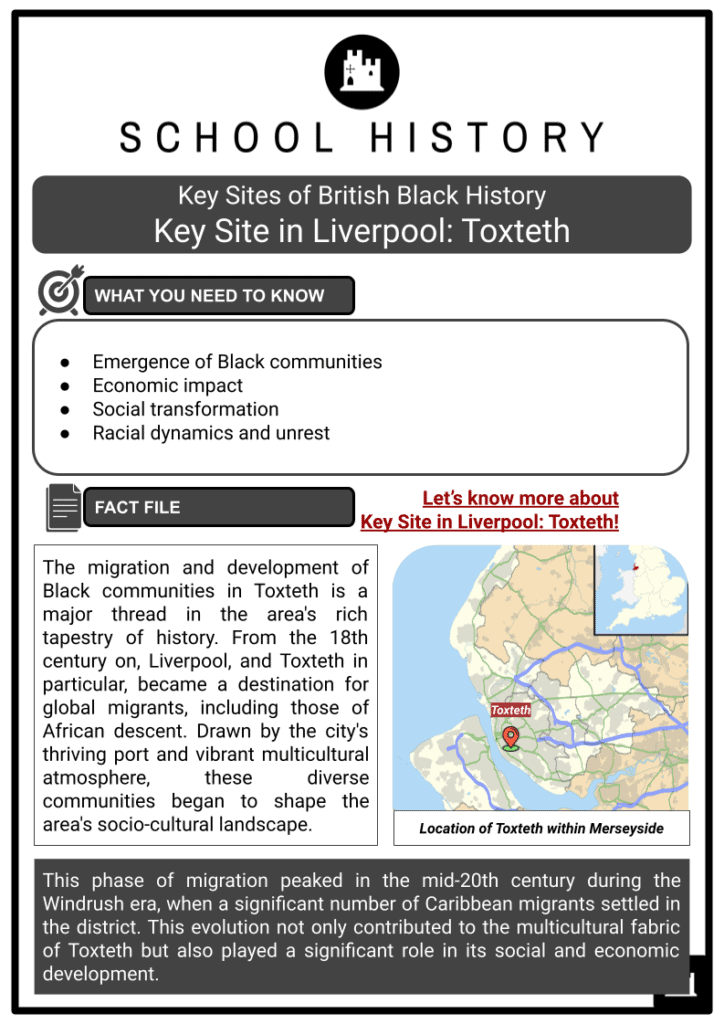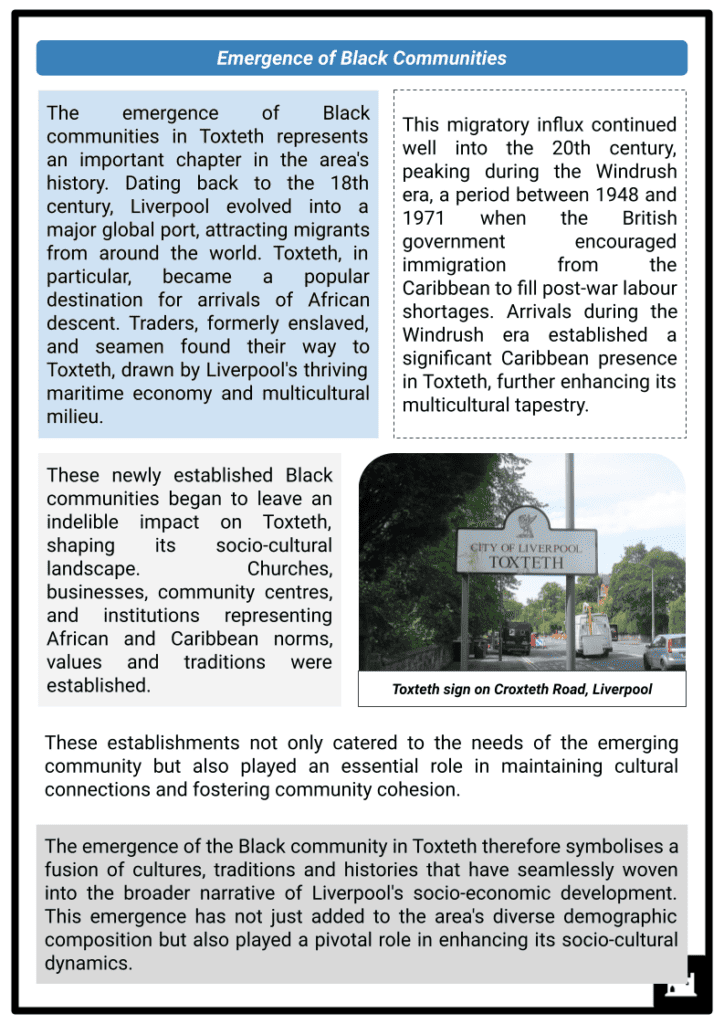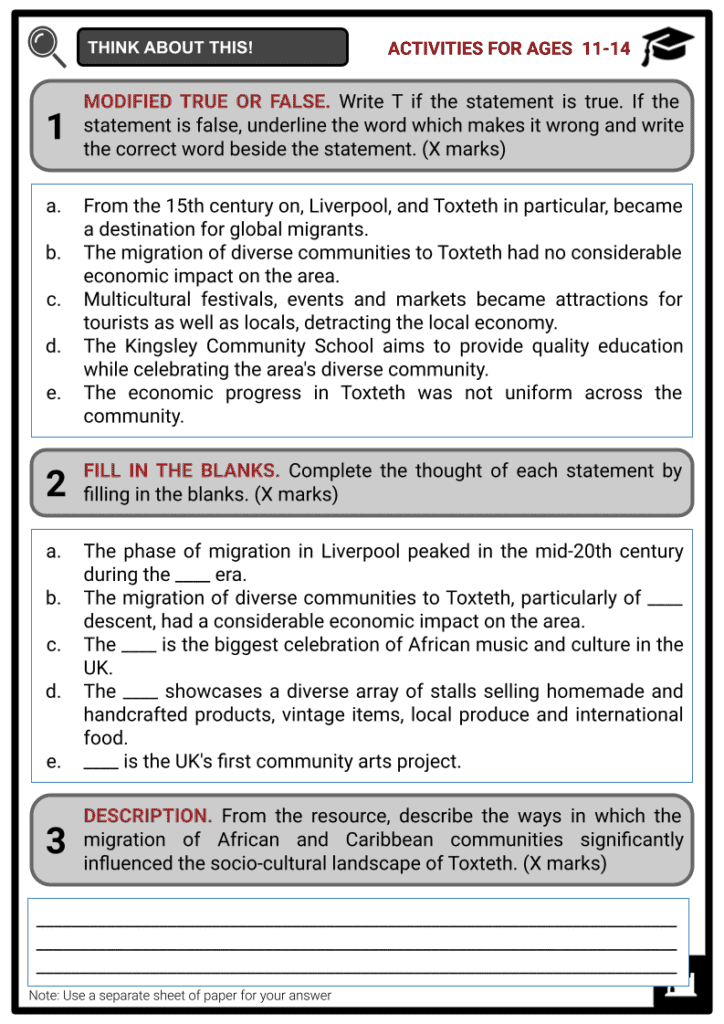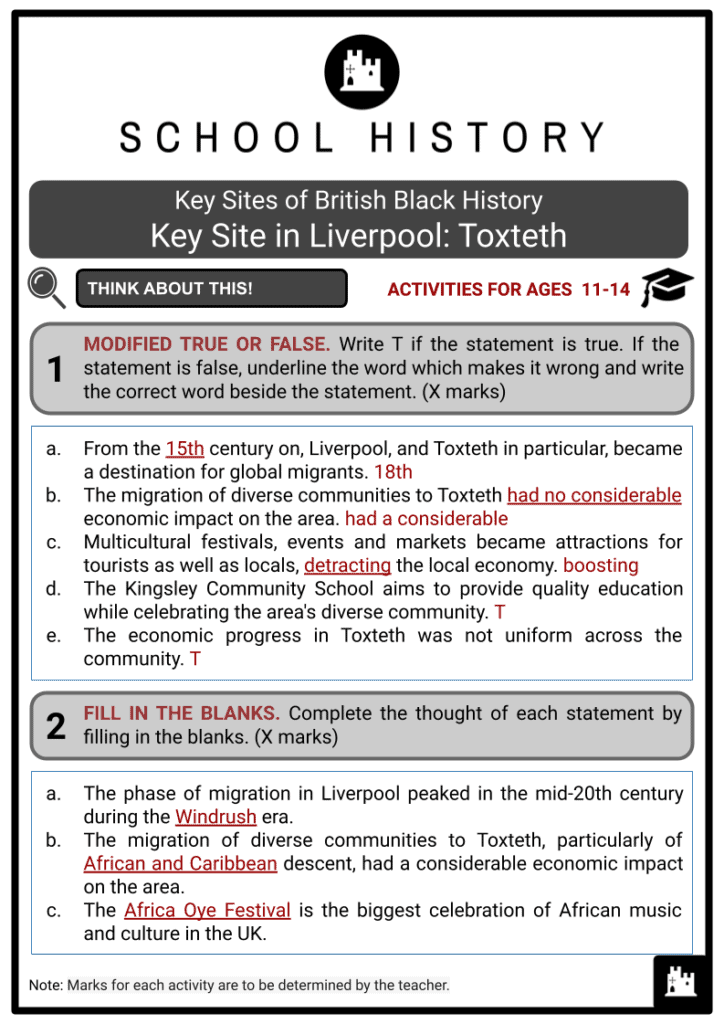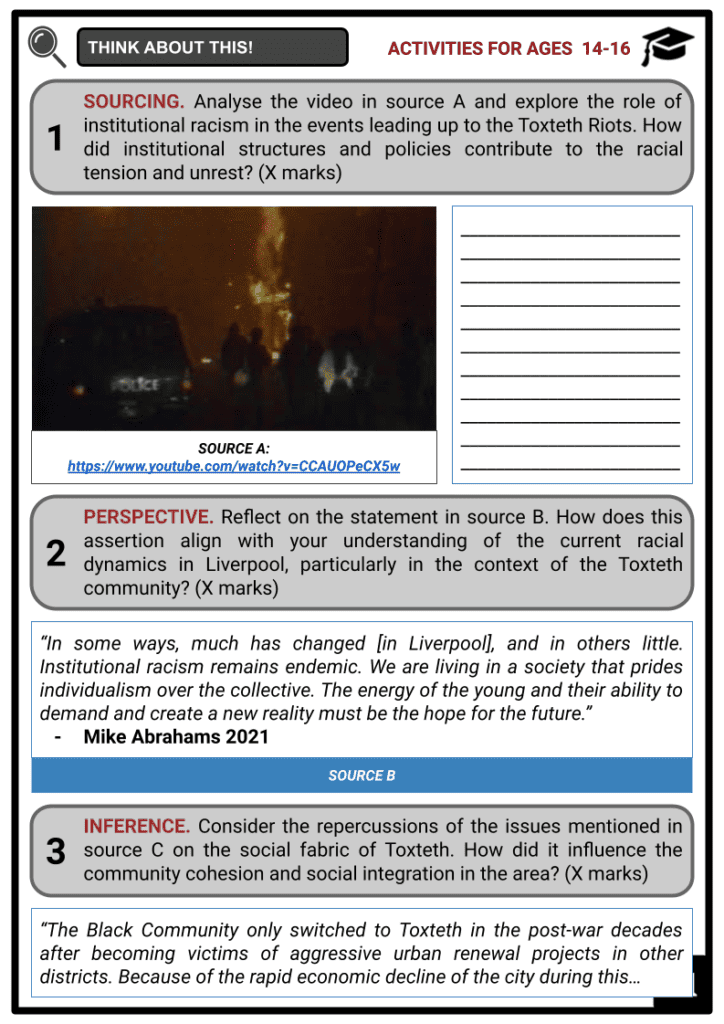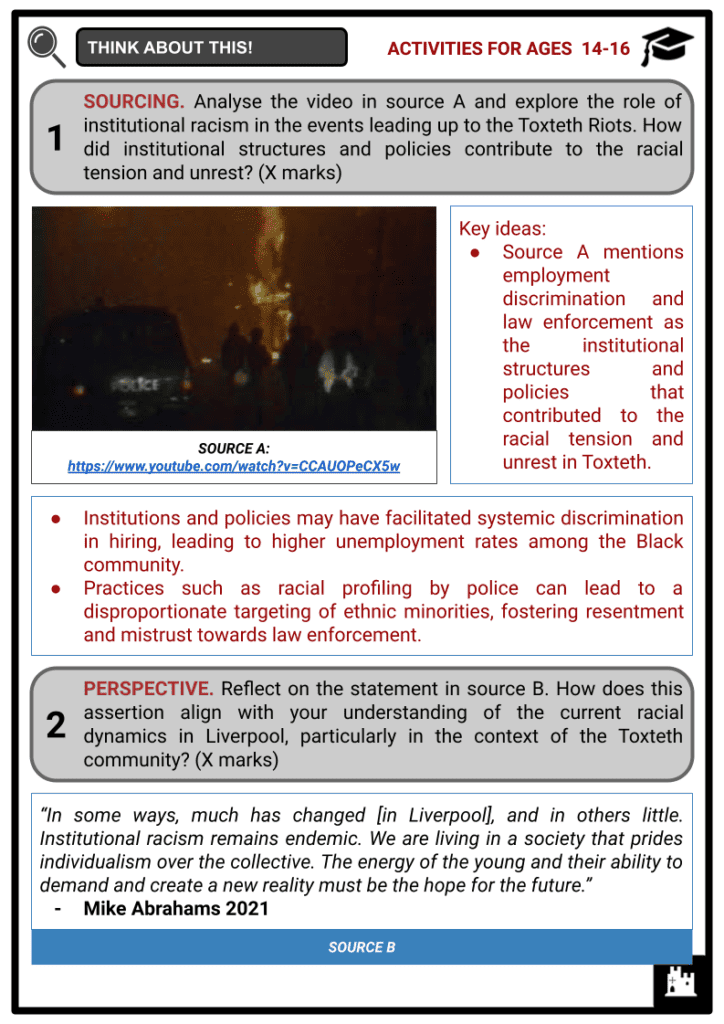Toxteth Worksheets
Do you want to save dozens of hours in time? Get your evenings and weekends back? Be able to teach about Toxteth to your students?
Our worksheet bundle includes a fact file and printable worksheets and student activities. Perfect for both the classroom and homeschooling!
Summary
- Emergence of Black communities
- Economic impact
- Social transformation
- Racial dynamics and unrest
Key Facts And Information
Let’s know more about Key Site in Liverpool: Toxteth!
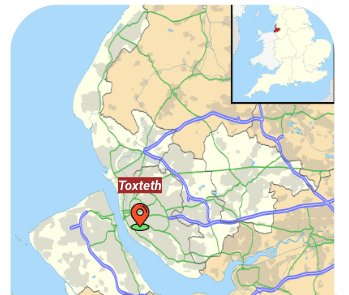
The migration and development of Black communities in Toxteth is a major thread in the area's rich tapestry of history. From the 18th century on, Liverpool, and Toxteth in particular, became a destination for global migrants, including those of African descent. Drawn by the city's thriving port and vibrant multicultural atmosphere, these diverse communities began to shape the area's socio-cultural landscape. This phase of migration peaked in the mid-20th century during the Windrush era, when a significant number of Caribbean migrants settled in the district. This evolution not only contributed to the multicultural fabric of Toxteth but also played a significant role in its social and economic development.
Emergence of Black Communities
- The emergence of Black communities in Toxteth represents an important chapter in the area's history. Dating back to the 18th century, Liverpool evolved into a major global port, attracting migrants from around the world. Toxteth, in particular, became a popular destination for arrivals of African descent. Traders, formerly enslaved, and seamen found their way to Toxteth, drawn by Liverpool's thriving maritime economy and multicultural milieu.
- This migratory influx continued well into the 20th century, peaking during the Windrush era, a period between 1948 and 1971 when the British government encouraged immigration from the Caribbean to fill post-war labour shortages. Arrivals during the Windrush era established a significant Caribbean presence in Toxteth, further enhancing its multicultural tapestry.
- These newly established Black communities began to leave an indelible impact on Toxteth, shaping its socio-cultural landscape. Churches, businesses, community centres, and institutions representing African and Caribbean norms, values and traditions were established.
- These establishments not only catered to the needs of the emerging community but also played an essential role in maintaining cultural connections and fostering community cohesion.
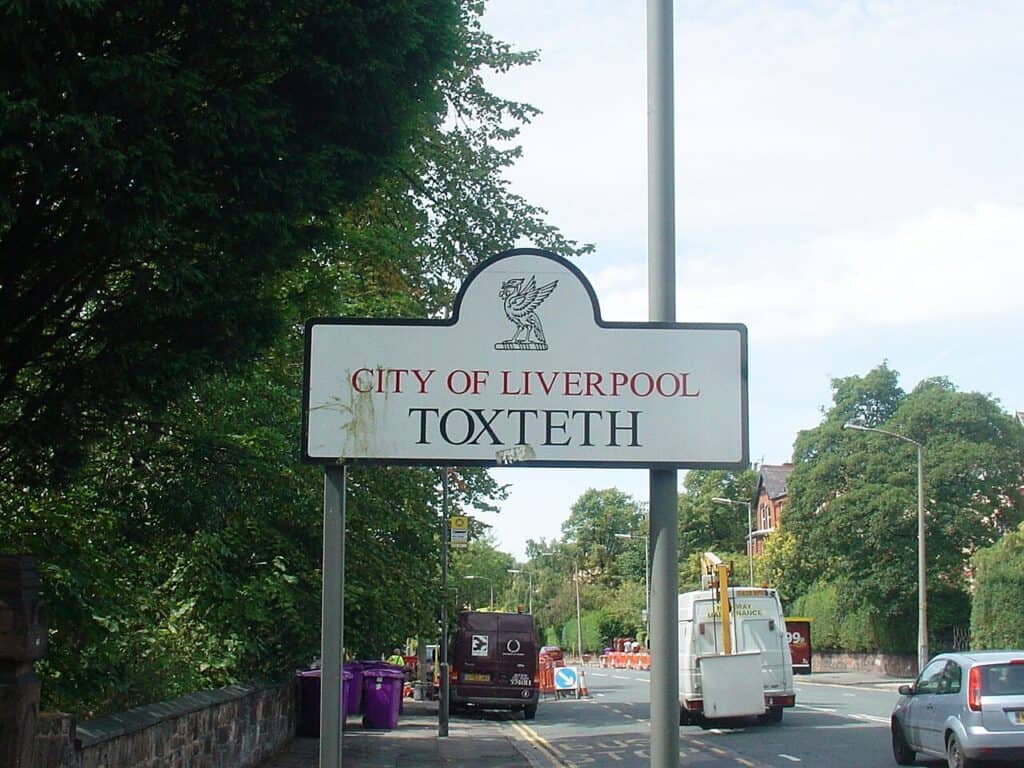
Toxteth sign on Croxteth Road, Liverpool - The emergence of the Black community in Toxteth therefore symbolises a fusion of cultures, traditions and histories that have seamlessly woven into the broader narrative of Liverpool's socio-economic development. This emergence has not just added to the area's diverse demographic composition but also played a pivotal role in enhancing its socio-cultural dynamics.
Economic Impact
- The migration of diverse communities to Toxteth, particularly of African and Caribbean descent, had a considerable economic impact on the area. The newly formed Black communities, many from the Windrush era, brought in a new wave of economic activity. They engaged in local trade, started their own businesses, and became an integral part of Toxteth's workforce.
- The establishment of African- and Caribbean-oriented businesses added a new dimension to Toxteth's local economy. These businesses ranged from local shops and eateries reflecting cultural taste to service-oriented establishments, providing options for the locals and catering to the needs of the growing community.
- These establishments not only provided services but also played a crucial role in enhancing and maintaining cultural identity, expression and aesthetics. In addition to the food and beauty industries, many service-oriented businesses sprung up, such as shipping services helping to maintain connections with home countries or specialised travel agencies providing travel services to Africa and the Caribbean.
- The cultural diversity of Toxteth became a source of economic opportunity. Vibrant multicultural festivals, events and markets became attractions for tourists as well as locals, boosting the local economy.
- On a larger scale, the cultural diversity enriched the workforce, contributing to a variety of sectors in Liverpool. The diverse community became a source of both skilled and unskilled labour, from trades and crafts reflective of their cultural heritage to employment in wider sectors such as transport, manufacturing and healthcare.
- However, it's important to note that the economic progress wasn't uniform across the community. Disparities in opportunities and access to resources led to economic inequality, manifesting as pockets of poverty and underemployment within the community. This created room for social tension, which would come into play later during periods of racial unrest.
Social Transformation
- The social transformation of Toxteth, driven by the arrival and settlement of Black communities, has been one of significant changes. The ever-changing population brought a range of cultural influences, which resulted in an evolving socio-cultural environment. The new inhabitants, largely from the Caribbean and Africa, brought with them their traditions, norms and values, which gradually started to reflect on the social life of the locality.
- These cultural influences were seen in the form of religious practices, food habits, music, language, and community activities. Churches, predominantly Protestant, became not only places for worship but also important community centres, offering various social services and playing a pivotal role in bringing together diverse cultural groups.
- The celebrations of cultural events and festivals like 'Africa Oye' became a significant part of the area's social life. The Africa Oye Festival is the biggest celebration of African music and culture in the UK, showcasing music, arts, crafts and food from Africa and its diaspora.
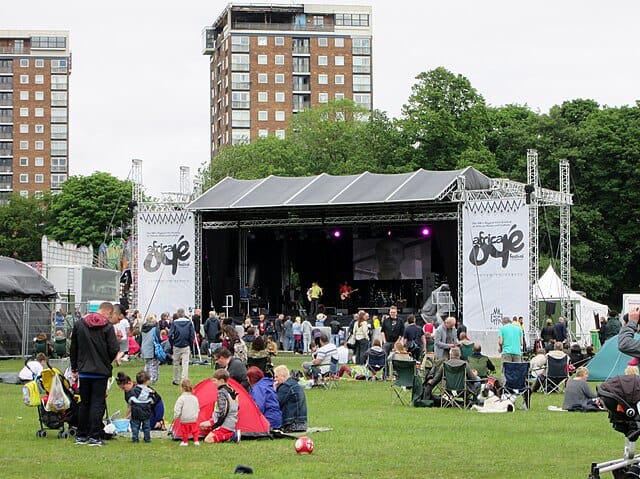
Africa Oye Festival - There's also the annual Caribbean Carnival in Liverpool, a vibrant display of Caribbean culture. It features traditional and contemporary Caribbean music, dance, fashion and food, attracting both locals and tourists.
- Toxteth also hosts multicultural markets such as the Granby Street Market. This community market showcases a diverse array of stalls selling homemade and handcrafted products, vintage items, local produce and international food. The market serves as not only a trading place but also a social hub celebrating cultural diversity.
- Events like the International Slavery Remembrance Day held at the International Slavery Museum in Liverpool create a platform for multicultural dialogue and remembrance, fostering greater understanding and respect for diverse histories and cultures.
- All these multicultural festivals, events and markets contribute to the richness of cultural life in Toxteth, reflecting its diverse demographic composition and fostering a sense of unity amid diversity.
- Education and community-focused institutions also played a vital role in the social transformation of Toxteth. They served as platforms for social engagement and civic participation, bringing together diverse community members and promoting intercultural dialogue.
- For instance, local schools like the Kingsley Community School aim to provide quality education while celebrating the area's diverse community. These schools often have multicultural curricula and programmes to promote cultural exchange and understanding among students.
- Community centres like The Black-E, the UK's first community arts project, provide educational and cultural programmes that celebrate Black culture and arts, fostering a greater sense of community and cultural identity. Toxteth Library serves as an educational institution that caters to the community's informational needs. It may also play host to various community events, workshops and educational programmes.
- These institutions highlight the importance of community and education in promoting unity and fostering understanding in a culturally diverse area like Toxteth.
- Toxteth's vibrant cultural life and its dedication to education and community engagement have been instrumental in bringing together diverse residents and fostering a sense of unity amid diversity.
- However, the constant interplay of different cultures was not always smooth and led to social tensions, especially during periods of racial unrest. Despite these challenges, the social transformation of Toxteth prompted by the emergence of Black communities has been noteworthy and has significantly contributed towards the creation of a multicultural and vibrant community.
Racial Dynamics and Unrest
- The racial dynamics and unrest in Toxteth present a complex picture of the challenges that the area faced while undergoing major demographic shifts. The advent of Black communities from Africa and the Caribbean significantly contributed to the diverse racial landscape of Toxteth. However, this multicultural milieu was not without its tensions and conflicts, particularly in the context of economic disparities and the experience of racial discrimination.
- Throughout the 20th century, Toxteth had several instances of racial unrest, the most significant of which the 1981 Toxteth Riots. Social and economic inequality, perceived racial discrimination by the police, and a lack of affordable housing all contributed to the intense period of racial and civil unrest that the riots marked.
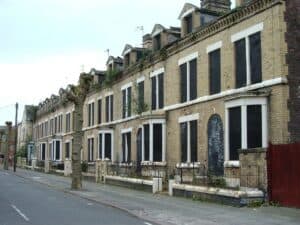
Derelict terraced houses in Toxteth - These factors created a combustible environment, leading to destructive riots that lasted for nine days. These events significantly impacted the Black community and marked a turning point in race relations in the area.
- However, in the aftermath of the unrest, there was increased awareness about racial injustices within wider society. Local and national initiatives were launched to combat racial injustice and promote social integration. Measures were adopted to reduce socioeconomic disparities, improve police–community relations, and foster mutual understanding and respect among diverse racial and ethnic groups.
- Over the years, racial dynamics in Toxteth have evolved with the steady influx of different ethnic groups and the ongoing efforts to address racial inequality. Despite prior racial unrest, the area has seen improvements in race relations and has become a vibrant, multicultural community. However, the journey is ongoing, and much work remains to ensure the full realisation of racial equality and harmony in Toxteth.
Image Sources
- https://upload.wikimedia.org/wikipedia/commons/thumb/6/66/Benkid77_Toxteth_sign_060809.JPG/1280px-Benkid77_Toxteth_sign_060809.JPG
- https://upload.wikimedia.org/wikipedia/commons/thumb/3/35/Africa_Oye_Festival_Sefton_Park_main_stage_-_geograph.org.uk_-_4569802.jpg/640px-Africa_Oye_Festival_Sefton_Park_main_stage_-_geograph.org.uk_-_4569802.jpg
- https://upload.wikimedia.org/wikipedia/commons/thumb/2/2d/Derelict_homes%2C_Toxteth.JPG/1280px-Derelict_homes%2C_Toxteth.JPG
Frequently Asked Questions
- What is the significance of Toxteth in Black history?
Toxteth, Liverpool holds significant historical importance in Black history due to its diverse community and the contributions of Black residents to the cultural, social, and economic fabric of the area. It was a centre of the civil rights movement in the UK during the 1980s.
- What events led to the civil rights movement in Toxteth?
The civil rights movement in Toxteth was sparked by issues such as police brutality, high unemployment rates, and poor housing conditions, which disproportionately affected the Black community. These challenges led to protests and activism in the area.
- What is the Black community in Liverpool's history?
Liverpool's Black community has a rich history dating back to the city's involvement in the transatlantic slave trade. Over the centuries, the community grew with the presence of immigrants from Africa and the Caribbean and post-World War II migrants. Liverpool's waterfront areas were central to the lives of sailors and traders.

